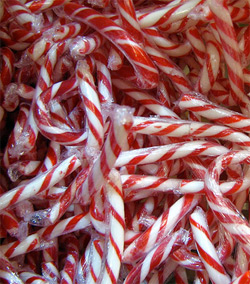So for the record, Tom Green didn’t dress up as Hitler at a bar mitzvah, the Hoover Dam doesn’t have bodies of workers buried inside, and candy canes? Oh, where do I begin. Perhaps with a warning: other than grappling with a particularly divine-tasting edible, a column about foodstuffs isn’t normally the place to tackle religion. Today it is, because the candy cane and Christmas are as intertwined as the stick’s red and white stripes.
I first read about the myth of candy canes (and Tom Green, and the Hoover Dam) on Snopes, the rumor-busting Web site. Paraphrased, this is the myth that Snopes tackled: Candy canes were created by a man in Indiana. He decided that the J-shape of the cane would stand for Jesus’ name, the white of the candy symbolized the virgin birth, the hardness of the candy correlated to the firm foundation of church, and the red stripes symbolized Christ’s bloodshed. A candy that symbolizes blood and sexless births? Yeah, that’s exactly what I’d like my child to put in his mouth at Christmas time. If only we could also make the ends pointy to symbolize the crown of thorns.
Now, I know I’m treading on, erhm, thorny ground here, hence the warning up top. The holidays are a deeply personal time, and those who celebrate Christmas can see it as everything from a no-frivolity honoring of Jesus to a practically religious-less holiday that is simply focused on celebrating family and friends. In short, when it comes to religion and all of its trappings, people interpret things how they want. Even things as small as candy canes.
But unlike arguments over the Bible’s stance on homosexuality, candy canes have some legitimate history suggesting that they aren’t quite so christly. Books about Christmas traditions (such as Ace Collins’ Stories Behind the Great Traditions of Christmas and Angie M. Mosteller’s Christmas: Celebrating the Christian History of American Symbols, Songs, and Stories) instead point to what happened at a living nativity scene at Germany’s Cologne Cathedral in 1670. Mosteller writes, “The choirmaster had great difficulty keeping the children of the choir in order. Plain white candy sticks were popular with the children, and the choirmaster believed that if they were kept busy licking candy, they wouldn’t chatter so much.”
Yup, candy canes were invented to fill the same purpose they often do today: to shut children up. Today they just sit in wicker baskets at banks.
This isn’t to say that the hard-candy sticks aren’t devoid of religion. Both Collins and Mosteller agree that the cane was meant to be a shepherd’s staff, but how the cane came to be a cane varies between the two sources. Mollester, who has the more overtly religious of the two books, says that the choirmaster wanted the children to “learn something of the significance of the nativity.” Collins, meanwhile, says that “the choirmaster wondered if the priests and parents would allow him to give the children in his choir candy to eat during a church service.” Thus, according to Collins, the only reason the lesson existed was because the choirmaster was trying to pull one over on the other adults.
That’s a Christmas tradition I’m eager to celebrate. • 11 December 2009
| “Traditional” Candy Canes |
 Those blood-red stripes weren’t added to candy canes until the early 1900s. Celebrate the original cane with these snow-white suckers. Those blood-red stripes weren’t added to candy canes until the early 1900s. Celebrate the original cane with these snow-white suckers.
1 cup sugar Cook the first four ingredients over medium heat, stirring occasionally, until a candy thermometer reads between 260 and 285 degrees. Remove the candy from the heat and stir in the extract, then pour the candy onto a well-oiled, heat-safe surface (I used a glass heat pad). Using a metal or silicone spatula, push around the candy until it becomes difficult to work. Then, with oiled hands, carefully (the candy is still quite hot) roll the candy, doubling it over, and roll it again. When the candy is opaque and just barely pliable, roll it thin, cut it into sections as long as you’d like, and round the ends into canes. Place on wax paper to harden. |




